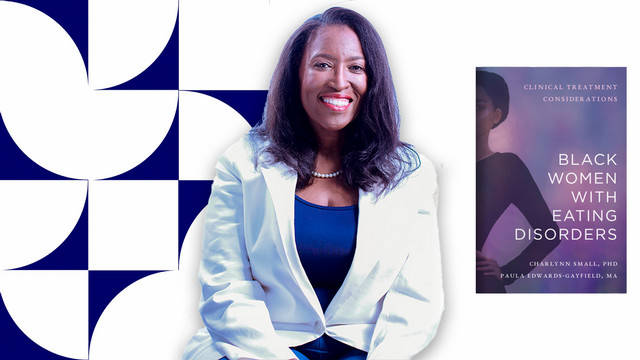New Book on Treating Black Women with Eating Disorders
New Research
University of Richmond’s Charlynn Small, a licensed clinical psychologist, aims to improve outcomes for Black women with eating disorders.
Many healthcare providers fail to recognize eating disorders in Black women.
In her new book Black Women with Eating Disorders, co-authored with Paula Edwards-Gayfield, psychologist Charlynn Small challenges long-standing myths about eating disorders in Black women and offers clinical insights that will empower both Black women seeking treatment and providers seeking to improve outcomes for Black women in recovery. Small’s research finds that Black women with eating disorders are significantly less likely to seek or receive help due to both an unjust healthcare system and systemic traumas like racism that are frequently not considered by some clinicians.
Here, she explores some of the root causes of eating disorders in Black women, the barriers to treatment that they face, and why a colorblind approach to treatment is not effective:
Can Black women have eating disorders?
Small: It is a common myth that Black women do not have eating disorders. It is crucially important for providers to understand that eating disorders manifest differently in Black women. Of the three most researched eating disorders — anorexia nervosa, bulimia nervosa, and binge eating disorder – Black women are most likely to experience binge eating disorder.
What are the causes of eating disorders in Black women?
For Black women in particular eating problems evolved as a response to interpersonal and societal trauma, including oppression and racism. Their daily lived experiences often include anxiety from acculturative stress events like invalidating, intimidating, and subtle microaggressions. Macroaggressions like housing discrimination, police misconduct, and other systematic social injustices can lead to patterns of emotional eating to cope with the effects of these events, often resulting in eating disorders. The super-additive impact of these events begs the question, “Are we eating because we’re hungry, or because something’s eating us?” In these cases, food is often used to allay and assuage fears and distress. Black women eat to soothe, to comfort ourselves.
Much of our negative lived experience is also about colorism: prejudice or discrimination against persons with dark skin, by persons with fair skin, usually among persons within the same racial or ethnic group. The impact of colorism contributes to negative body image issues and are associated with a greater risk for developing eating disorders.
In addition, Black children experience adverse childhood experiences at rates much higher than White children, with sexual abuse being among the highest events. And because there is a clear correlation between sexual trauma and eating disorders, it is crucial to assess for and rule out these kinds of traumas.
What should treatment for Black women with eating disorders look like?
Different people often need different things — Black women are not monolithic. Efforts should always be made to use any of the evidence-based approaches in culturally adaptable ways. Specifically, practitioners should be cautious to consider a client’s cultural, ethnic and racial backgrounds during treatment. Treatment will be most successful when practitioners consider those things that are important to their clients. A colorblind approach to treatment is wholly inappropriate because it merely relieves a practitioner of their obligation to address race and related issues. In doing so, it is likely that very important issues or concerns will either be overlooked or dismissed as unimportant.
What is the most effective clinical treatment for eating disorders?
There are many effective treatments for these disorders. Among the most effective evidence-based treatments is cognitive behavioral therapy (CBT), considered the gold standard by many. CBT aims to modify negative thought patterns and behaviors through the use of cognitive restructuring and exposure therapy. Another treatment that is quite useful is called the unified protocol for emotional disorders (UP). UP addresses the underlying mechanisms of emotional disorders. The aim is to improve regulation of emotions, reduce symptoms, and enhance quality of life.
